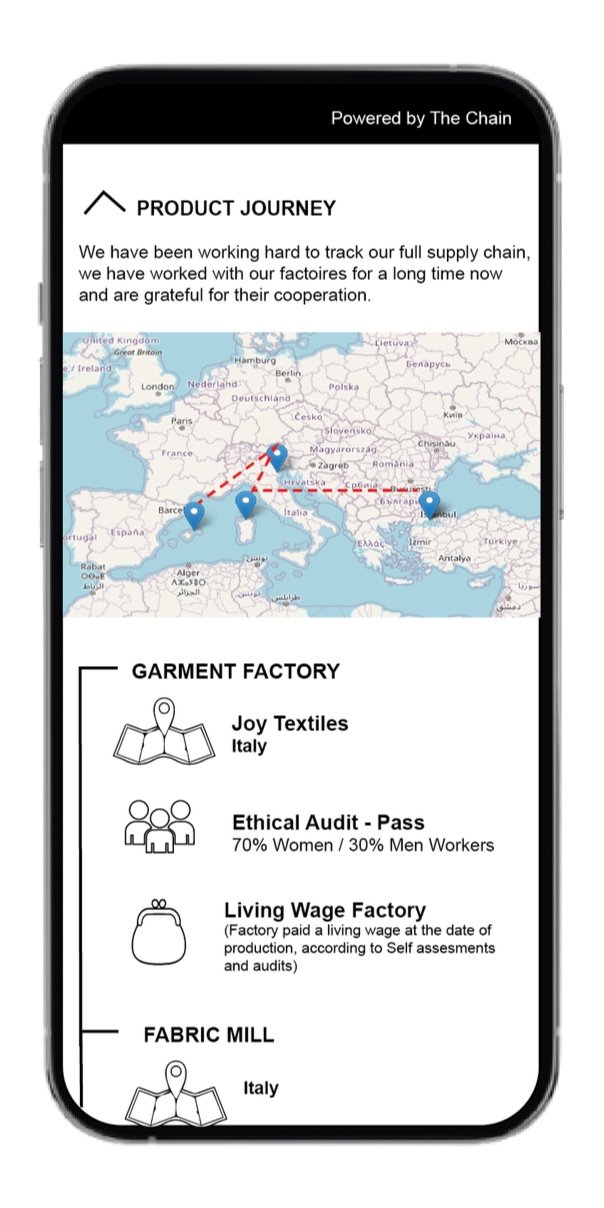Should We Be Taking Digital Product Passports Seriously—Or Will They Be Forgotten Before They Start?
The Short Answer: Yes. Very Seriously.
Written by Frankie Hewitson (FrankCo & The Chain Director)
For anyone in the fashion industry wondering if the Digital Product Passport (DPP) is just another passing regulatory trend— maybe think again. The DPP is a cornerstone of the EU’s Circular Economy Action Plan, embedded within the broader European Green Deal. This initiative is not only real, but legally binding, and it’s already reshaping the future of how fashion products are made, marketed, and sold within the European Union.
What Exactly Is the Digital Product Passport?
The Chain Digital Product Passport
At its core, the Digital Product Passport is a dynamic digital record that travels with each product. It holds detailed information about the item’s full lifecycle: where and how it was made, what it’s made from, its environmental footprint, and how it can be reused, repaired, or responsibly disposed of. It’s typically accessed through a QR code or another digital tag.
The goal is transparency—not just for regulators, but for consumers and recyclers alike. Imagine scanning a tag on a jacket and seeing exactly what it’s made of, who made it, how much CO₂ it generated, and what to do with it when you're done wearing it. That’s the future we’re heading toward.
The Legal Reality: It’s Already Law
Unlike some sustainability guidelines that remain voluntary or vaguely enforced, the DPP is backed by serious legislation. It was made official through the Ecodesign for Sustainable Products Regulation (ESPR), which became EU law in July 2024.
For fashion brands, the rollout begins now. In January 2026, the EU will publish a Delegated Act specific to textiles, setting out exactly what information must be included. Enforcement will begin by mid-2027. By 2030, full implementation is expected across all applicable categories, with further expansion likely beyond that.
Non-compliance won't be taken lightly. Penalties may include fines or even restrictions on accessing the EU market.
This Applies to All Fashion Brands—Not Just the Big Ones
It doesn’t matter if you’re a multinational or a niche startup: if you sell apparel or footwear in the EU, you’ll need to comply. Small and medium-sized enterprises (SMEs) won’t be exempt either, although the EU has acknowledged the extra burden on them and has signaled that financial support and guidance will be made available.
This makes DPPs one of the most wide-reaching sustainability mandates ever applied to fashion—and one that levels the playing field.
How the Industry Is Responding
Forward-looking brands aren’t waiting for the final deadline. Large brands are already rolling our Digital Product Passports this year and others are ensuring their ducks are in a row ready to launch next year. (there’s a lot of information to get)
But implementing a DPP isn’t as simple as attaching a QR code. It requires tracking extensive data—up to 110 distinct data points per product—across complex supply chains. It demands close collaboration with suppliers, investment in digital systems, and a shift in mindset from linear production to circular design.
Beyond Compliance: Why This Matters
While compliance is certainly a driving force, the DPP also presents a rare opportunity for brands to differentiate themselves. Consumers are increasingly seeking transparency. Being able to show exactly what’s in a product—and how ethical and sustainable it really is—can build trust and loyalty in a way marketing alone never could.
DPPs also support business models based on resale, rental, recycling, and repair. With proper documentation, a jacket that’s five years old can still enter a second-hand market or a take-back program with all its details intact. This is foundational for the circular economy—and increasingly, for brand survival.
What to Expect Next
Implementation will be phased to give the industry time to adjust. The EU has proposed a three-step approach: a simplified version in 2027, a more advanced passport by 2030, and a full circular product record by 2033. This gradual rollout is designed to allow brands to build up their data infrastructure and partnerships without getting overwhelmed.
As of now, 16 key data categories are expected to be included in the passport—covering everything from materials and supply chain details to environmental and social impact. The final list will be confirmed in the upcoming delegated acts, but what’s clear is that supply chain transparency, material composition and certification is a must!
What Brands Should Do Now
This isn’t something you can tackle overnight. If you're a fashion brand and haven’t already started preparing, now is the time. Begin by mapping your supply chain more thoroughly and collecting the basic product data that will be required first. Ideally connect with a third party tech platform. We do the mapping and data input for you (if you sign up to the full package) By partnering with a third party, you automatically stay fulling informed on any regulation changes, and you can be assured you are meeting legal requirements.
Final Thoughts
The Digital Product Passport is not a trend. It’s the beginning of a new era in fashion—one where transparency isn’t optional and circularity is non-negotiable. For brands that embrace it, there are real strategic benefits. For those that ignore it, the cost of catching up later may be far higher than the cost of preparing now.
Either way, one thing’s for sure: the DPP is here to stay.
We offer free DPP for all full package clients, if you would like to hear more about how The Chain can help with your DPP’s please reach out below.


